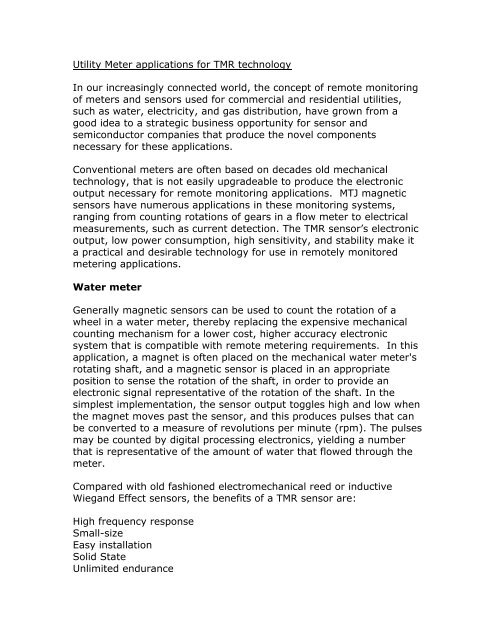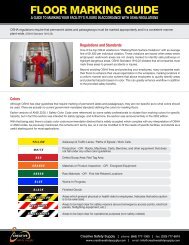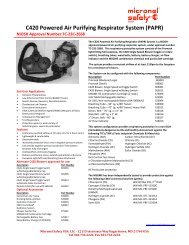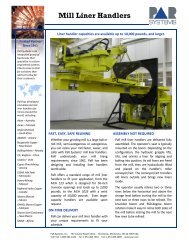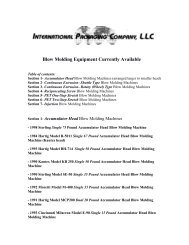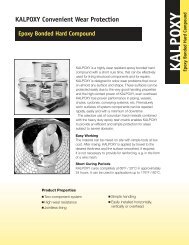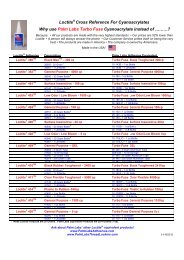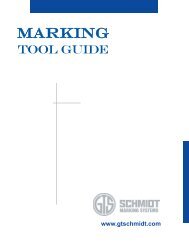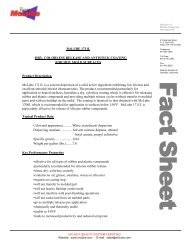Utility Meter applications for TMR technology In our ... - ThomasNet
Utility Meter applications for TMR technology In our ... - ThomasNet
Utility Meter applications for TMR technology In our ... - ThomasNet
You also want an ePaper? Increase the reach of your titles
YUMPU automatically turns print PDFs into web optimized ePapers that Google loves.
<strong>Utility</strong> <strong>Meter</strong> <strong>applications</strong> <strong>for</strong> <strong>TMR</strong> <strong>technology</strong><br />
<strong>In</strong> <strong>our</strong> increasingly connected world, the concept of remote monitoring<br />
of meters and sensors used <strong>for</strong> commercial and residential utilities,<br />
such as water, electricity, and gas distribution, have grown from a<br />
good idea to a strategic business opportunity <strong>for</strong> sensor and<br />
semiconductor companies that produce the novel components<br />
necessary <strong>for</strong> these <strong>applications</strong>.<br />
Conventional meters are often based on decades old mechanical<br />
<strong>technology</strong>, that is not easily upgradeable to produce the electronic<br />
output necessary <strong>for</strong> remote monitoring <strong>applications</strong>. MTJ magnetic<br />
sensors have numerous <strong>applications</strong> in these monitoring systems,<br />
ranging from counting rotations of gears in a flow meter to electrical<br />
measurements, such as current detection. The <strong>TMR</strong> sensor’s electronic<br />
output, low power consumption, high sensitivity, and stability make it<br />
a practical and desirable <strong>technology</strong> <strong>for</strong> use in remotely monitored<br />
metering <strong>applications</strong>.<br />
Water meter<br />
Generally magnetic sensors can be used to count the rotation of a<br />
wheel in a water meter, thereby replacing the expensive mechanical<br />
counting mechanism <strong>for</strong> a lower cost, higher accuracy electronic<br />
system that is compatible with remote metering requirements. <strong>In</strong> this<br />
application, a magnet is often placed on the mechanical water meter's<br />
rotating shaft, and a magnetic sensor is placed in an appropriate<br />
position to sense the rotation of the shaft, in order to provide an<br />
electronic signal representative of the rotation of the shaft. <strong>In</strong> the<br />
simplest implementation, the sensor output toggles high and low when<br />
the magnet moves past the sensor, and this produces pulses that can<br />
be converted to a measure of revolutions per minute (rpm). The pulses<br />
may be counted by digital processing electronics, yielding a number<br />
that is representative of the amount of water that flowed through the<br />
meter.<br />
Compared with old fashioned electromechanical reed or inductive<br />
Wiegand Effect sensors, the benefits of a <strong>TMR</strong> sensor are:<br />
High frequency response<br />
Small-size<br />
Easy installation<br />
Solid State<br />
Unlimited endurance
Power meter<br />
A current flowing through a wire produces a magnetic field that flows<br />
circumferentially around the wire. This magnetic field has an intensity<br />
and polarity proportional to current magnitude and direction. Thus a<br />
<strong>TMR</strong> sensor placed in proximity of a wire provides a voltage that can<br />
be used to measure the current flowing through a wire. Hall Effect<br />
sensors (“Hall sensors”) are often used <strong>for</strong> this application, but Hall<br />
sensors are not ideal. The intrinsic thermal stability of Hall sensors is<br />
poor because of the Hall Effect depends on carrier concentration in a<br />
semiconducting element, which is intrinsically dependent on<br />
temperature, thereby requiring some method to compensate.<br />
Additionally, Hall sensors have relatively low sensitivity to magnetic<br />
field, and they often require the presence of a permeable flux<br />
concentrator or slotted ferrite ring to amplify the field produced by the<br />
current flowing through the wire. This increases system size and cost<br />
beyond the mere cost of the Hall sensor. Because of this low<br />
sensitivity per<strong>for</strong>mance and inherent temperature dependence that<br />
increases the size and cost of Hall sensor equipped meters, <strong>TMR</strong><br />
current sensors are much better suited <strong>for</strong> smart power meter<br />
<strong>applications</strong> than Hall sensors.<br />
Gas meter<br />
Like a water meter, a gas meter is effectively a type of flow meter that<br />
measures consumption in terms of the cumulative rotation of a<br />
spinning shaft. <strong>In</strong> an analogous manner to their use in water meters,<br />
<strong>TMR</strong> sensors may also be used in utility gas meter <strong>applications</strong>. <strong>In</strong> a<br />
simple but effective implementation, a magnet is often placed on the<br />
meter's main shaft, and a magnetic sensor is placed in an appropriate<br />
position to sense the rotation of the magnet. The sensor output<br />
toggles high and low when the magnet moves past the sensor, and<br />
this produces pulses that can be converted to a measure of revolutions<br />
of the shaft. The pulses may be counted by digital processing<br />
electronics, yielding a number that is representative of the cumulative<br />
amount of gas that flowed through the meter, thus yielding a measure<br />
of gas consumption. The advantages of <strong>TMR</strong> sensor over reed<br />
switches, Wiegand Sensors, and Hall sensors result in lower meter<br />
cost, smaller size, and better metering reliability.


